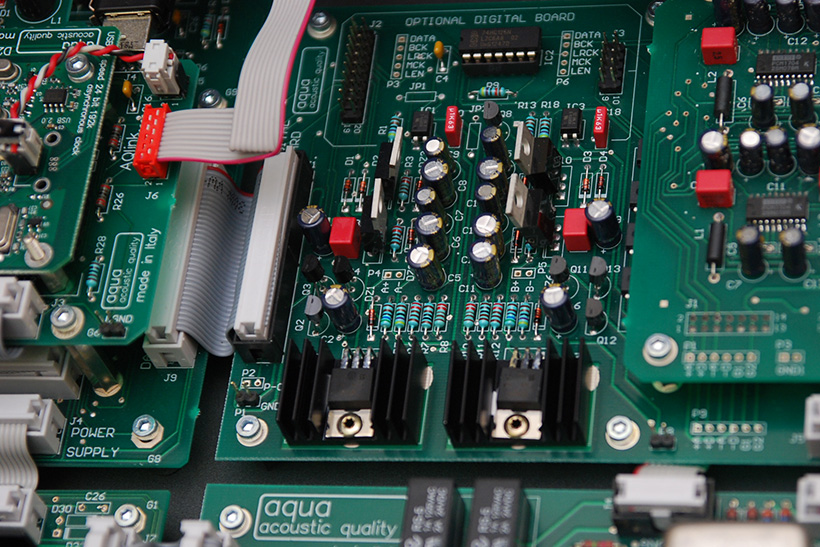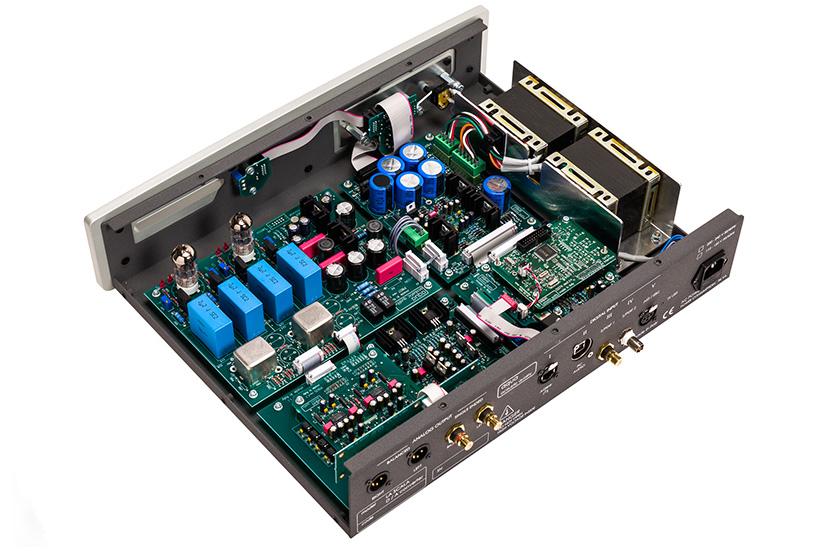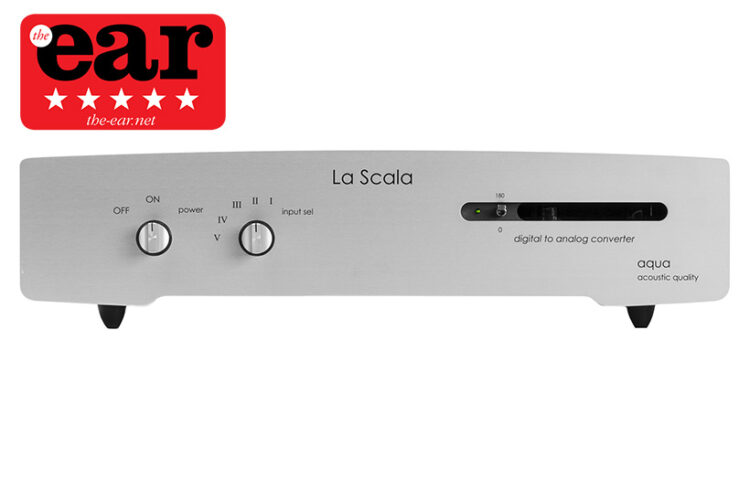As soon as anyone removes the grey Nextel coated cover of the Aqua (Acoustic Quality) La Scala Mk II DAC he or she will see that they mean serious business in Italy. Where a lot of converters today consist of one or two boards with highly integrated SMD components, Aqua has chosen to use seven upgradable printed circuits boards to hold mostly discrete components. I’m not even counting the PCBs behind the front panel controls and back panel connectors. No wonder this DAC carries a firm price tag, the question is does the performance live up to this electronic promise.
The aluminium faceplate is not the oblong standard but has a distinctive shape and even a slot that provides cooling for the two double triodes inside the box. On the left a pair of rotary knobs switch the unit on/off and let you choose one of the five inputs. A phase switch is added for those who are sensitive to such things. On the back are XLR balanced and RCA single ended outputs alongside five digital inputs including an I2S for the propriety AQlink between transport and DAC. A balanced 110 Ohm AES/EBU input, S/PDIF over RCA and BNC and of course USB type B complete the roster but an AT&T optical connection is optional. All inputs accept at least 24 bit/192 kHz rates and the AQlink will handle 384 kHz sample rates. A small LED indicates the presence of a digital stream.

I squared S
Inside the box Aqua uses asynchronous coupling for USB and PPL for S/PDIF to eliminate jitter. The AQlink over I2S will bring the best performance says Aqua, but you need the La Diva or another compatible transport. The incoming digital signal is not oversampled, hurray for that, Aqua does not follow the standard path but prefers sound quality it seems. The next step is a high performance proprietary DFD (Direct From Decoder) digital decoding without the use of digital filters. The DAC chips are Burr Brown PCM 1704K types, four of them used in a differential dual mono configuration, followed by current to voltage transformers. The digital part of the DAC is separated from the analogue ground by high speed opto couplers.
A pair of long life ECC81 tubes is used in the analogue stage, followed by MOSFETs to lower the output impedance and reduce distortion without the need for feedback. The tubes are biased with LEDs for ultimate stability, these form a visible row behind the front panel slot. A soft start circuit elongates tube life. On the RCA outlets one half of each tube carries the signal, while on the XLR outputs both halves of the triodes are used, to produce a high output voltage of (measured) 3.5 Volt to 7 Volt. You have to make sure your amplifier can handle such high output levels. Four trimmers inside La Scala were precisely adjusted and showed less than 0.1 Volt difference between pins 2 and 3 on the XLRs. Aqua is proud to say that not a single op-amp is used in the output stage.

Boba FET?
The power section, separated into a digital and an analogue supply is also of very high quality. The two transformers pull between 25 and 30 Watts continuous power from the mains to feed Aqua’s discrete regulator circuits (with MOSFET, J-FET and BJT) for the analogue and digital stages. A virtual battery circuit provides the anode current. Ultra-fast diodes are used along with other high quality parts like long life capacitors and low noise metal foil resistors. Most connections are made with flat cable, elsewhere audiophile cable is used. All in all La Scala shows that the Aqua company was more concerned about designing a high quality DAC than making savings or compromises.
To get the best out of the DAC it was put into my system alongside an Esoteric D-07 converter and G-03X wordclock. The main digital source is a NAD M50/M52 network streamer, connected with an Apogee Wide-Eye XLR or Stereovox VX2 RCA/BNC to the DAC. Although USB is very popular, I prefer to use almost any DAC over XLR or S/PDIF. USB might be nice to connect a small desktop DAC and play your music while you are at work, in my main system a network player with a NAS or a dedicated music server mostly does a better job. Would you really like a laptop next to a high quality DAC like La Scala and be bothered every week with software updates and the like? I prefer to use my spare time enjoying music. Since my preamp and power amp are fully balanced I connect a pair of Van den Hul D102 Mk3 cables to the Aqua’s XLR outputs. The power amp feeds a pair of PMC fact.12 loudspeakers in a, for acoustics sake, modestly tuned room. Mains power is cleaned for all electronics for better performance and a lower noise floor, except for the power amplifier. Most cabling comes from Crystal Cable, Supra and Yter. A stable Quadraspire rack accommodates all equipment.

XLR vs RCA
The DAC needed about two weeks of continuous power to reach peak performance, during this time I often compared the sound quality against my own DAC and found that La Scala became its equal. Not that the Aqua and Esoteric sound the same, they differ, but both are satisfactory to say the least. After the warm-up time it soon became clear that La Scala has two faces, a pinpoint soundstage between the loudspeakers when the RCA (coax S/PDIF) input is in use and a broad soundstage on XLR (AES/EBU balanced). A track from a Dali Loudspeakers demo disc called Down In The Hole by John Campbell shows that on RCA the depth is much larger, but the smaller stage has the disadvantage that details on the left side seem to disappear in the rest of the instruments. While on XLR these details are easily heard and standalone, however the stage is less deep. It is like a piece of clay, pull on the sides and it flattens, push the sides in and its form goes in the opposite direction. Differences don’t stop with just the soundstage, on RCA the sound is crisper and has some more attack, deep bass tones or a bass drum lose a bit on impact, voices become a little clearer in my view. On XLR a softer presentation is produced, bass has this nice ‘boom’ that only slowly fades, it’s closer to the sound of a live bass drum. The softening of the voices also adds that little extra in emotional transfer. I realise that this could be due to the cables used and/or be part of the NAD M50 performance as well. No matter what causes the difference, in the long term I prefer a balanced digital connection to La Scala for the most rewarding and often outstanding results.

Never too late
Holly Cole is one of my all time favourites and I put on One Trick Pony from her album Romantically Helpless, it really shines. A big bass guitar to start, fingers snapping, light percussion and Holly enters the listening room. Her voice clear as could be and full of articulation. The band makes the music lively and guitars flash on either side of the speakers. A few tracks later we have Come Fly With Me, this time the band forms a background for Holly, with firm bass tones and almost a wall of sound. La Scala does an excellent job separating the band members and especially keeping Holly as the star performer. Secret Love from Claire Martin on a Linn high res recording puts down a piano that makes you feel like you are in a jazz club somewhere in London. La Scala creates a very intimate concert, close to the stage but never in your face. Even when the music speeds up and brass instruments take over I find no need to turn the volume down. Split from Patricia Barber is the first time that I want to add speed to this DAC, the track Early Autumn should have more impact than I get. Especially the piano, which can rock your chair and have you dancing around the room on some other converters, not on this one, maybe it is just a little too polite. Where Ms Barber’s slower work shines the up tempo tracks from this 1989 album have not got the X-factor. On the other hand play Two For The Road and you soon forget and forgive what you played before. A consideration for the listener, do you like a motorway ride or take a country road. Given the way Two For The Road sounds I am willing to forgive La Scala just about everything, I cannot get enough of this album because of the excellent result on the slower tracks. Bass clear and plucked, piano one of the very best I have had at home, voice engaging, percussion tender and detailed. The lady might sing It Is Too Late Now, well believe me it isn’t too late to get one of these great DACs.

Family sound
Antonin Dvorak once composed a String Quintet in E Flat Opus 97, it was recorded by the Berlin Philharmonic String Quintet for an SACD on the Pentatone label. I ripped the CD layer to a FLAC file and I enjoy this dynamic and well recorded piece of music as often as I can. It has that nice bite, the clear tones of a violin, just on the edge like a violin should be and deep cello tones. Ripped the same way is Legende from Giovanni Angeleri, music composed by Pablo de Sarasate. The first track starts very loud but soon the volume is lowered, making room for the solo violin, but also for a tambourine that has to be there throughout the track. Now I know a lot of DACs that mess up this music and leave the tambourine out of the picture. Not La Scala, its performance is soft like a babies skin, tender as its caring mother, strong as daddy has to be. It’s informative and yet very musical. Playing very loud is no problem, tones barely heard on the recording stand out beautifully. If you do not own this SACD you might call your local store or order it from a website. Beware, your system has to handle the high volumes and the converter must be able to handle tiny digital signals. Oh and in case you want to find the tambourine, it is in the back on the right channel. To end the listening session I lined up Francois Chaplin plays Chopin Nocturnes. This 24 bit/88.2 kHz file shows once again how well La Scala handles piano, the best ever for my system. The right size with lower registers under the fingers of the left hand filling the room impressively, the higher notes pinpointed where they ought to be. The sound is majestic to say the least and when I play the same piece on my beloved Esoteric DAC later on it sounded disappointing. Not that the D-07 plus wordclock are suddenly bad products, not at all, but the Aqua La Scala is the superior one.
It is music
I could listen for hours and hours with this DAC to every kind of music you can think of. Lounge music, country, pop, jazz, baroque or any other classical music. Only occasionally did I long for a little extra speed from this great piece of electronics. A bit more drive on some CDs is all I desire. A minor wish because La Scala has presented itself as one of the most beautiful and capable digital to analogue converters I’ve had in my home system. I know it’s expensive and that DACs are available for less than one tenth of the retail price, but for me it is worth the money because of the excellent way all music is handled. Details never show up as if under a magnifying glass but they are no doubt there. On RCA or BNC the sound stage is a bit small but very deep. On XLR the stage is wide but not as deep. But I lose interest in these details as soon as I start listening to music. In the long term it all comes down to music not the technology, the Aqua La Scala has stolen my heart in so many ways that I hate to see it go. Whatever comes next to convert my files into analogue will have to face the impression La Scala leaves. I have put it on the top of my wish list and as soon as my own DAC fails beyond repair I will call the Italians to get a La Scala shipped to my place. It not only brings music, it is music, and that is the biggest compliment I can give the makers of this extremely fine product.


